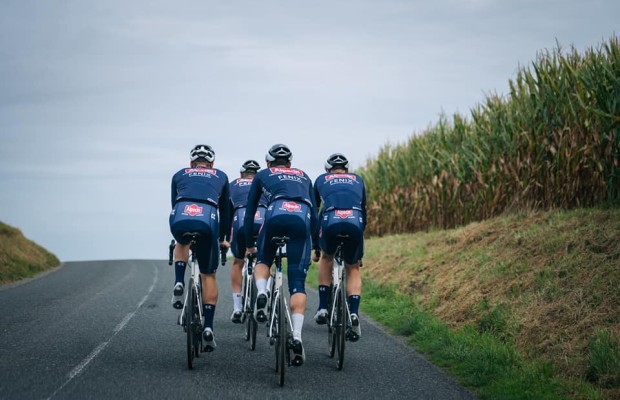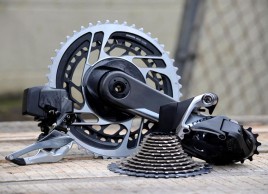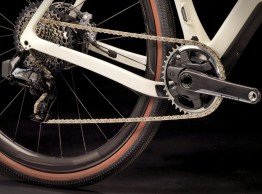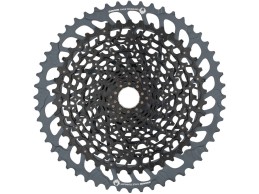When is it necessary to change the gear ratio of your bike and what size of chainring and cassette to choose?
A few years ago, when groups had 8, 9, 10 sprockets, one of the cyclist's usual concerns was choosing the right gear ratio for their bikes. Nowadays, with 12-speed groups, it's something that has been somewhat forgotten, and yet paying attention to it can make us enjoy our cycling outings more.

What gear ratios do you need on your bike
Today, with the standardization of gear ratios and the wide range offered by current 12-speed groups, few people wonder if the gear ratio of their bike is suitable for the use they make of it. However, when we come across cyclists struggling on climbs or some on flat terrain who are unable to keep up with a group because their legs can't handle it, we realize that the one-size-fits-all approach decreed by the brands is not always ideal. Fortunately, we still have options to adapt the available gears on our bike to our use, the terrain we usually ride on, and, of course, our physical level.
We start with road cycling, a discipline in which undoubtedly, we find more versatility thanks to the continued use of two chainrings along with the 12 sprockets of current groups, which allows for a wide range between extremes while maintaining a very progressive step between adjacent gear ratios.
RECOMENDADO

Benefits of training in the cold

The cyclist's patience: how long, gentle training sessions build your best season

Tips for cycling in the rain

25 cycling gifts ideas to get it right

When do helmets have to be changed? Do they have an expiration date?

Some reasons to stay away from the road in winter

In recent years, we find two trends, first that of Shimano and Campagnolo, which maintain large chainrings and, in recent times, have designed their rear derailleurs to be able to use a larger extreme sprocket, 34 teeth in their option of the highest range cassette. However, more traditional options of chainrings with 52/36 as the most standard option are still available. SRAM, on the other hand, also has cassettes that go up to 33 teeth, but starting at 10 and opting for smaller chainrings, 48/35, as the most common configuration.
Fortunately, the three brands also offer smoother gear ratios such as the 50/34 from Shimano and Campagnolo, an option that is perfect for the cycling enthusiast who loves big climbs, although it has inexplicably fallen out of use, or gear ratio options only suitable for professionals such as the 54/40 from Shimano's Dura-Ace or the 50/37 from SRAM.

For gravel use, gear suppliers have opted to introduce versions with smoother gear ratios from their road groups or specific groups derived from these. SRAM, which uses the same groups for road and gravel, calls its options with smoother gear ratios XPLR, also usable on the road, with an 11-44 cassette and a shorter option in double chainring of 46/33 and in single chainring a 36 as the smallest available chainring.
On the other hand, Campagnolo has its specific group of 13 sprockets Ekar and Ekar GT where we find up to 48 teeth as the largest sprocket and single chainrings ranging from 44 to 36. Finally, Shimano has its GRX groups with up to 51 teeth in the rear sprocket and single chainrings of 42 or 40, or in a double chainring version 48/31.

In mountain biking, the single chainring has become popular. In this modality, the gear ratio variation focuses more on choosing the most suitable chainring, which is combined with cassettes with a huge range that covers from a 10-tooth sprocket to a 50, 51, or even 52-tooth sprocket and chainrings that usually range from 30 to 38.
How do I choose the best gear ratio for my bike?
To know what we need, the first step is to consider the terrain we ride on and how we usually feel when pedaling, and what sprockets we usually use. If most of the time you are using extreme gear ratios, both at the top and bottom, it will be a clear sign that perhaps we should adapt the gear ratio of our bike to a longer or shorter one. On the contrary, if we distribute the use across the entire range, it is a clear indication that the chosen option is suitable for us.
When choosing the gear ratio of the bike, we must consider what we find in most situations. Obviously, if we live in a flat area and one day we go up climbs and find ourselves stuck on a particular steep climb, it is something to consider but should not lead us to make a decision beyond, if anything, having a gear ratio option only for those special days.

In this regard, perhaps using a single chainring allows us greater flexibility simply by having a couple of chainrings to face different situations. For example, someone who uses their gravel bike for both off-road and road riding can have a 42-tooth chainring for use on asphalt and a 38-tooth one for off-road riding. Replacing a chainring is a matter of just five minutes.
Obviously, we could also have a couple of cassettes with different tooth counts, but we must bear in mind that the variation between one version and the next of the cassette is hardly noticeable in the final result unlike the chainring, whose effect on the entire gear range is more significant. Besides, we may be surprised to find that we usually use one cassette and when we want to use the other on one of those special days, the chain skips due to wear, something that does not usually happen if we choose to replace the chainring, an element that experiences less wear than the sprockets in general.

If we use a double chainring, the choice capacity is limited. With the cassette, we encounter the same problems as mentioned before, and changing the tooth count of the chainrings, apart from being more laborious, would also require us to readjust the height of the derailleur to achieve optimal operation. On the other hand, the wider range of available gear ratios makes it much less likely that we will need to change gear ratios, although it requires a much more careful initial choice.
We remind you that the way to calculate the gear ratio, that is, the meters you advance per pedal stroke, consists of dividing the number of teeth on the chainring by the teeth on the sprocket to obtain the gear ratio, a figure that we will multiply by the circumference of the wheel. Knowing this, we can create a simple Excel table to help us, knowing which gear ratios we use the most, to choose so that most of the time we engage intermediate ratios and have margin both at the top and bottom.

In any case, falling short of gear ratio regularly, for example, if we live in a flat area and often ride in groups, or needing a longer one to tackle climbs regularly, will be clear indicators that we need to adapt the gear ratio of our bike, something that, on the other hand, also varies greatly depending on our physical condition.